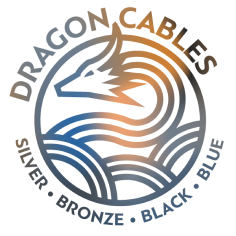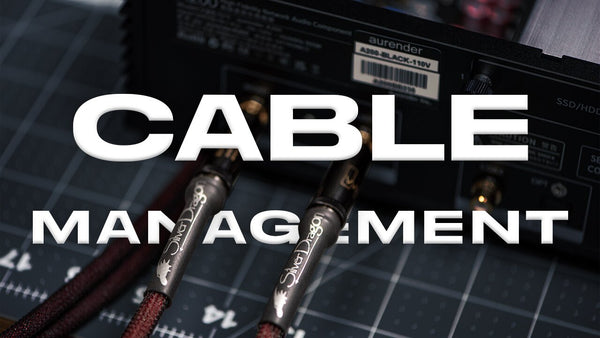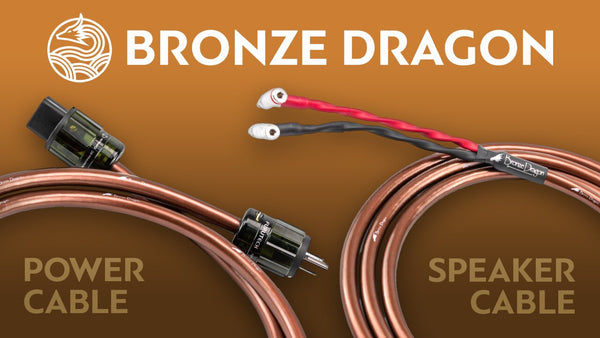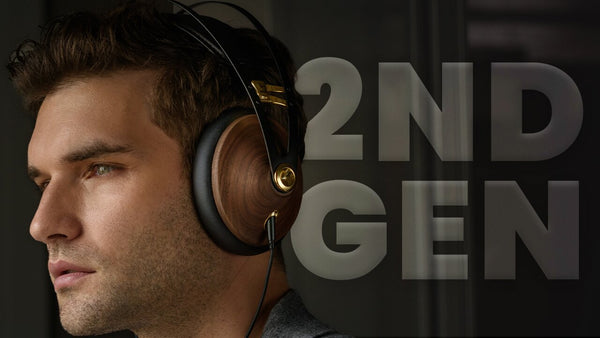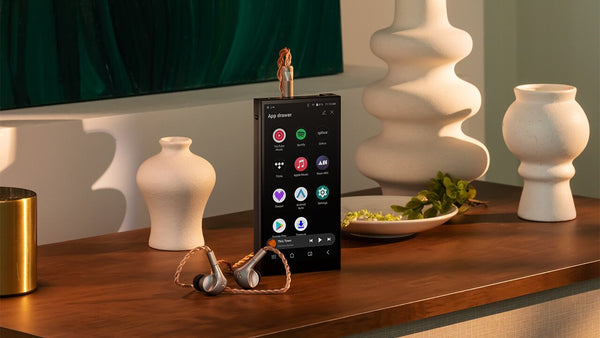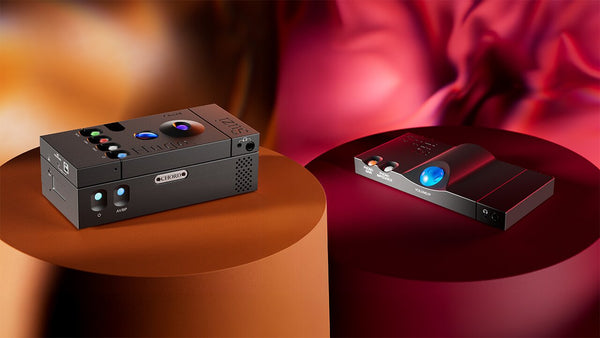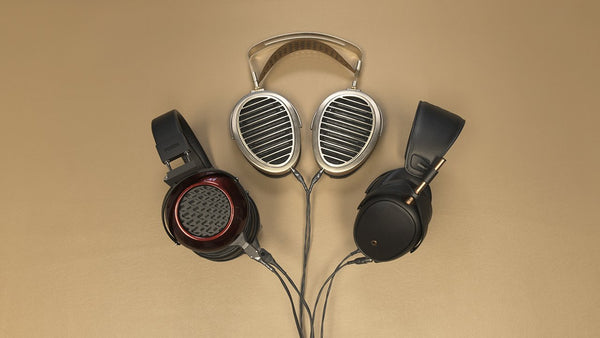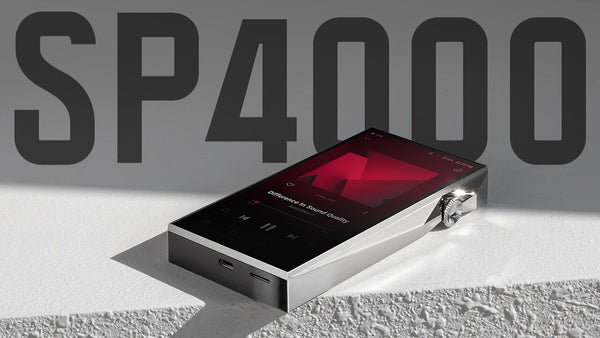Balanced vs. Unbalanced Audio Cables: Everything You Need to Know

Are Balanced Audio Cables Better for Your Audio System?
Cables matter. They’re an important part of the equation if you are trying to make your system as clean-sounding as possible. Not all cables are created equal and are oftentimes an oversight in improving the sound quality and clarity of your system. Whether you're working with an audio interface in recording studios or setting up a home audio system, the cables are what actually carry from your source to your output, so the materials used and the quality of the cable itself have a dramatic impact on what you are going to hear. Things like noise rejection, cable length, and input gain/level are all very important to consider when determining what cable solution and audio equipment is best for you and your system.
Cables come in two varieties: balanced and single-ended. On their own, one is not necessarily better than the other for your audio interface or preamp. What matters is the application for which they are used, and which cable will be most effective in carrying out the best signal to your components. The common myth is that balanced vs unbalanced cables have a clear winner. Why is that? Well, probably the top reason people think balanced input and balanced output connections are better is that they offer superior noise rejection and protection against unwanted noise. The last thing you want to hear when trying to listen to your high-quality audio system is static, hiss, or other noise artifacts in your system diminishing the quality and clarity of your music.
Let's take a look at how balanced cables are able to keep out the noise in their signal.
Understanding Balanced vs. Unbalanced Connections
Q: Is Balanced signals better than unbalanced signals for audio quality?
A: It Depends. There are a lot of details to think about: Determining what kind of "balance" you want (i.e. cables, amp, headphones), the circuitry/signal path of the amp, how a piece of equipment fits into your overall system, headphone, or IEM impedance. A/B testing units cable length, headphone compatibility, connector type, etc. In some cases single-ended sounds better than balanced and in other cases balanced sounds better than single-ended.

The idea that balanced audio is better than single-ended audio is a myth. The term "balanced" can refer to cables, signal path, and circuitry of amps. It's important to know that balanced cables work better in some scenarios and single-ended cables in others. Headphones cannot be balanced because they are just speakers, but the connection to a balanced or single-ended amplifier can make all the difference (though it depends on the amplifier and the headphones.) Balanced adapters are always a bad idea for single-ended cables because they can damage your gear.
Common Mode Rejection
Most people think about 'balanced' as a Common-Mode Rejection, where you're using long runs of balanced cables between two pieces of equipment. In each cable, you have two signal wires: a plus and a minus, and the ground line. Both the send and receive lines carry a copy of the signal, but with the polarities reversed. The receivers look at both ends, average out the signal-to-noise ratio, and get rid of the noise by flipping the polarity. This is called Common-Mode Rejection because the noise is the 'common' signal between the send and receive lines. All balanced cables utilize common-mode rejection.
However, common-mode rejection is not really "balanced," it more so describes the function of how the dual lines work to cancel out external noises in that signal. Oftentimes common-mode rejection is referred to when talking about balanced cables rather than balanced circuitry. Therefore, most people have the impression that a balanced connection is superior because it is more resistant to external signal noise sources. While this is true, it does not necessarily mean that the balanced line is "better" than a single-ended cable.
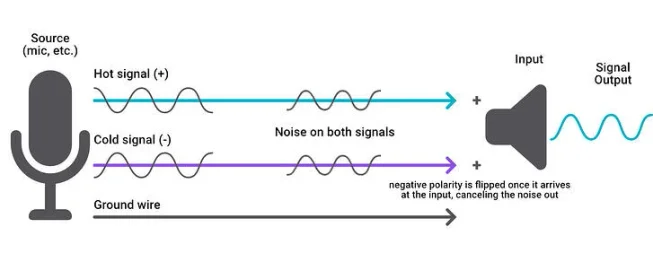
Noise or common-mode voltages can come from numerous sources, so the differential amplifier must be efficient and effective at eliminating the noise.

Unbalanced or single-ended cables, on the other hand, do not have dual polarity lines. The ground wire in unbalanced lines serves two functions: it carries part of the audio signal and also shields the main signal wire (partially) from outside noise interference. Because of the internals of single-ended cable design, however, the line can also act as an antenna in picking up external noise sources. This is why limiting single-ended cables to shorter lengths is greatly preferred over longer lengths. The longer the cable - the more noise it can pick up.
Short length single-ended cables are good for noisy signal environments and for low-level signals from instruments (keyboards, guitars, etc). Because of their native low-level signal, any noise interference is not amplified by more active sources or higher-level/gain signals.

BALANCED AUDIO
- Two signal wires (a plus and a minus) and the ground line
- Send and receive lines carry a copy of the signal with the polarities reversed
- Receivers average out the signal-to-noise ratio and get rid of noise by flipping the polarity
UNBALANCED AUDIO
- No dual polarity lines
- Ground wire carries part of the signal while shielding the main signal wire (polarity) from outside noise interference
- Line can act as an antenna picking up external noise sources
Cable and Connector Types
You can generally tell if you have a balanced or single-ended cable based on the connector at the end of the cable.
Balanced Cables typically have either XLR Connectors or TRRS Connectors
Balanced XLR cables have a 3 or 4-pin tip while TRS cables have a quarter-inch connector with two rings dividing the "tip," the "ring," (x2), and the "sleeve" (T-R-R-S). There are also other balanced cable types that have 4 or 5-pin configurations. Typically, these XLR connector types are solely used for a balanced headphone, microphone input, or balanced speaker output.
Also, keep in mind that balanced cables tend to be more expensive than single-ended options. Some of that has to do with the popularity of balanced cables for long cable runs due to their noise interference.
What We Like
More resistant to noise interference
More durable and effective at longer cable lengths–anything longer than 20 or 25 feet+
Lower impedance rating
What We Don't Like
More expensive
Balanced (Interconnects)

XLR Connector (Multiple Pin Variants)

TRS & TRRS Connectors
Q: Are Balanced Audio Cables Better?
A: Not Necessarily. It really depends on the application. Balanced cables are more resistant to external noise or interference due to their capacity for common-mode rejection. Common-mode rejection allows for balanced cables to have less noise in the signal path. This is more noticeable in headphones as opposed to speakers due to the proximity of the source to the ears. Some people like having noise in the signal, for instance, when listening to an analog source like a turntable. In referring to headphones, it depends on the headphone amplifier that is connected to your headphones, rather than the cable itself.
But in some applications, single-ended cables might be better, and a more economical option compared to balanced cable solutions.
Unbalanced Cables typically have either RCA, 3.5mm TRS, or 1/4-inch (6.35mm) TRS Connectors
Unbalanced cables have a variety of connectors to include RCA, 3.5mm TRS, and 1/4-inch TRS. These connectors are widely used in consumer-grade audio equipment and are easily identifiable by their simple, two-conductor design for a signal and ground.
RCA connectors are often seen in home audio systems, connecting devices like CD players to amplifiers. 3.5mm TRS, often known as a "mini jack," is a common connector for headphones and is found in many personal audio applications. 1/4-inch TRS is a larger version used for more demanding gear like amplifiers, electric guitars, keyboards, and some headphones.
Unbalanced (or single-ended) cables are more susceptible to noise interference and are most effective at lengths up to 20-25 feet.
What We Like
More cost-effective
Under 10 feet unbalanced cables actually have a stronger signal than balanced cables
Great for low-level/gain signals like instruments
What We Don't Like
More susceptible to noise interference
Only effective at cable lengths up to 20-25 feet
Unbalanced/Single-Ended (Interconnects)
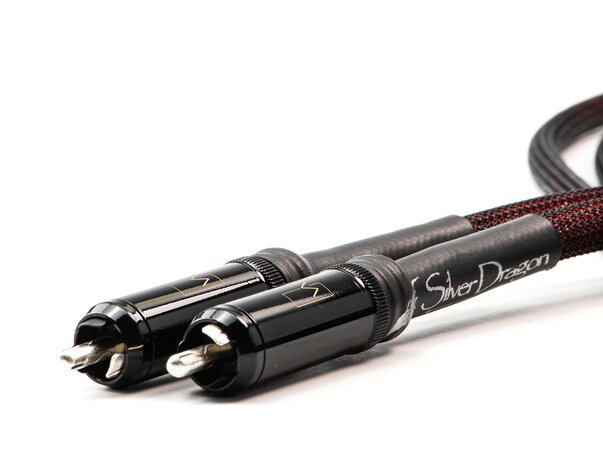
RCA Connector
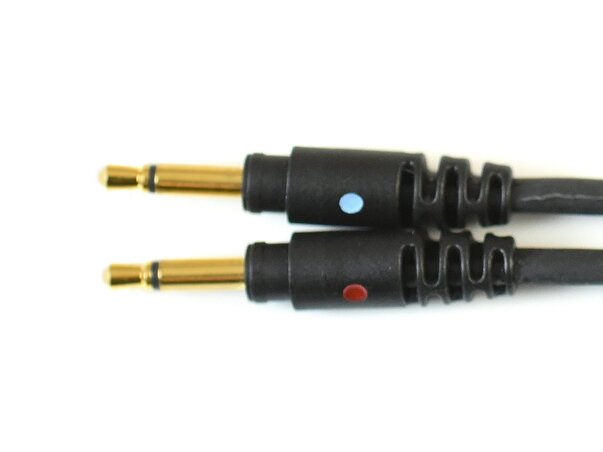
TS Connector

SpeakON Connector
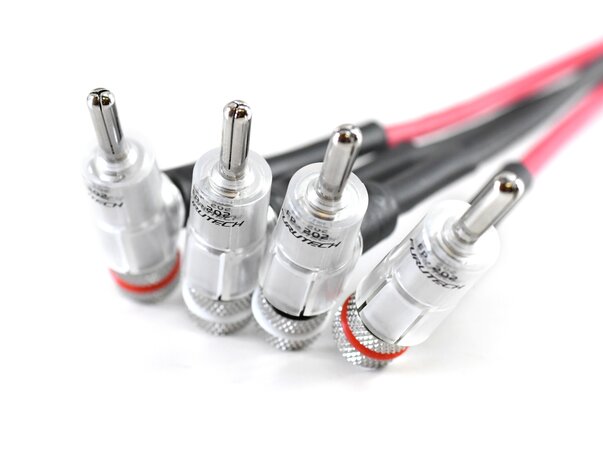
Banana Plug Connector
Headphone Cables
Interconnect cables typically connect a component device to another component device. Headphone cables are directly connected to the headphones themselves (or through detachable methods). Headphones are not balanced or single-ended because they are just speakers, unable to do common-mode rejection. They can only receive signal and output analog sound. The cable that is connected to the headphones, on the other hand, can be balanced or single-ended. Headphone manufacturers have various connector types for their equipment, but the end-point to your amp or DAC will always be either an XLR or TS/TRS connector.
Common Balanced Headphone Audio Connections:
- Dual 3-pin XLR Connectors
- Single 4-pin XLR
- 2.5mm TRRS
- 3.5mm TRRS (not to be confused with 3.5mm TRS)
- 4.4mm TRRRS
Common Single-Ended Headphone Audio Connections:
- 1/4" (6.35mm) TRS
- 1/8" (3.5mm) TRS
Dragon Audio Cables: A Headphone Cable for every listening Scenario
Do your headphones have an attached cable with a connector that is not compatible with your gear? No problem.
Here at Moon Audio, we know a thing or two about audio cables. From Interconnects to digital cables, headphones, and IEM Cables, we handcraft cables for every listening scenario. Our Dragon Audio Cables are designed to bring out more of what you love in your music and we have a plethora of connectors and terminations to fit just about every headphone on the market. From Meze Audio to Sennheiser, Dan Clark Audio, and HiFiMan we've got you covered.
Silver Dragon Premium Headphone Cable
The Silver Dragon is our top-of-the-line flagship headphone cable. The Silver Dragon is designed to maximize the amount of detail, clarity, air, and instrument separation you get from your listening experience. We use only the purest UP-OCC silver available in our Silver Dragon Premium Cables. Silver is the best conductor and is more expensive to produce than copper, hence the Silver Dragon's status. Silver conductors are adept at pulling out "lost" middle and high-frequency sounds, so you get top-end sizzle and hear things that may otherwise be obscured.
The Silver Dragon is smooth and clean, not forward or bright sounding. We recommend the Silver Dragon for people who love to hear lots of detail in their music.
Black Dragon Premium Headphone Cable
Now if your goal is more warmth and musicality, the copper conductor Black Dragon is going to appeal to you. The Black Dragon uses 99.99998% UP-OCC Copper conductors to provide warmth, musicality, and depth to your headphones. How? Copper strands enhance the body, shape, and immediacy of your music for more of that "I'm there" feeling. The Black Dragon is a very neutral-sounding cable that's going to enhance the body, shape, and immediacy of your music for a more immersive sound.
The Black Dragon will smooth out the top end without compromising detail. It's a great cable for vocals and a range of genres, especially Rock and Roll, Electronica, R&B, Pop, and other music with a big, bold presentation. The smooth, musical quality makes it a perfect fit for headphones that tend to sound a bit edgy or bright. And despite its warmth, the Black Dragon does not have a laid back, lush sound.
Blue Dragon Headphone Cable
Aside from our Silver and Black Dragon Premium cables, we also make a Blue Dragon Headphone Cable. The Blue Dragon is the most neutral-sounding of our dragon cables, delivering you a clear, neutral, and uncolored sound. It features 4 x 24AWG Teflon-Insulated stranded conductors using pure single crystallized UP-OCC pure copper with 7N purity 99.99998%. It's a great choice when a more natural, organic sound is desired.
The Blue Dragon will clean the sound without warming or brightening it. Think of the Blue Dragon as a wipe for your eyeglass lenses — Removing obstructions and making it clearer without altering your prescription. If you're looking to add clarity to your headphones but don't want any coloration, this is the cable.
Balanced vs. Unbalanced Headphones
Is a balanced headphone better than a single-ended? Don't let this question fool you, find out the real answer.
Cable Placement

Depending on the placement of the cables, you can also minimize the amount of interference intercepting the signal. For instance, if you have single-ended cables, running them perpendicular along power lines (as opposed to running them parallel) will minimize the amount of noise that will enter the signal. Because the cable only has a single polarity it is unable to do common mode rejection and is thus more susceptible to noise and interference.
Noise interference is not a concern with balanced cables on the other hand since they can do common-mode rejection.
So, in applications where you are running lines near power sources or over longer distances, balanced cabling would be preferred over single-ended. In scenarios where you do not need long cable solutions and proximity of power lines are not a concern, single-ended cables should be just fine.
If your sole factor in determining the cable you need is based on noise and interference concerns, then in some cases you can save money and opt for more budget-friendly single-ended cables. If you are very detailed about the placement of your wires and make sure there is no power current crossover, you have shorter cable lengths, etc, then you could potentially get away with single-ended solutions. But you'll have to assess this on a case-by-case basis. Environmental factors, RF, various wireless signals, power cable placement, and much more need to be factored in to make the best decision on the proper cable type and requirements for your situation.
Dragon Audio Cables
So, now that you know a thing or two about balanced vs. unbalanced audio cables, let us present you with our exquisite collection of Dragon Audio Cables, perfect for your system. We make Dragon Audio Cables for virtually every system configuration imaginable, with the ability to customize your cable's terminations and connectors. Don't see a cable choice that works for your scenario? Contact us and we can walk you through the process of building a custom cable!
But we didn't stop there! We've got a collection of adapter cables which you can browse, but make sure to check out our blog 'Unbalanced or Balanced Headphones' to make sure an adapter cable is exactly what you need.

Our HiFi Audio Dragon Cables bring out more of what you love in your music and audio gear. If you love your headphones but wish they had a bit more top-end sparkle - a Silver Dragon Headphone Cable would be a great option. If your USB cables keep dying - as many stock cables do - then check out our quality USB Audio Cables. We say time and time again that materials matter, and our audio cables and custom geometries actually help to bring out those desired properties in your gear and music. We make tons of custom options for our customers so that you can get the right HiFi Audio cable for your exact needs. If you have any questions feel free to Contact Us and we'll be more than happy to help.

The Right Cable For the Right System
Cables have the power to make your signal extremely clear or extremely poor. They are an integral component to your system that often gets overlooked or treated as an afterthought. Keep in mind that balanced cables are not necessarily better than single ended cables. It depends on what you plan on using them for: longer cable runs versus shorter runs, need for noise resistance, signal chain, components and inputs/outputs, etc.
If your signal/source is unbalanced, then using a balanced cable is not going to add any sonic benefit or enhance your sound. The connectors at the ends of your cable must also be appropriate for the cable type. For instance, if you attach TRS connectors to a single-ended cable, it does not magically make it a balanced cable.
On the other hand, if you connect a single-ended cable to a balanced source, it will still "work" and transfer the audio signal, but it will also still be susceptible to noise interference since it will not be able to utilize common-mode rejection (and is ultimately not advised).
Application is key. If you use the wrong cable for the wrong application, it can actually be detrimental to your sound. Knowing how to use your gear appropriately and for the right purpose can make all the difference. Explore our collection of Dragon Audio Cables and upgrade your sonic fidelity today. Don't forget to check out our additional blogs on balanced vs. unbalanced headphones and audio gear.
Related Videos
How to Adapt Single-Ended Cables to Balanced Connections?
Choosing the Right Digital Input for your Setup
Dragon Headphone Cables 101

